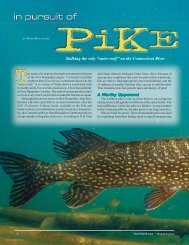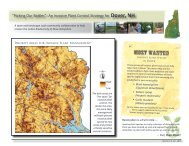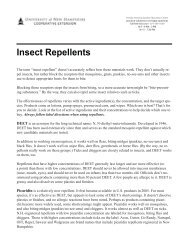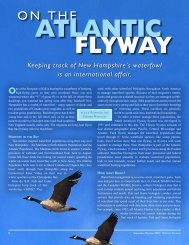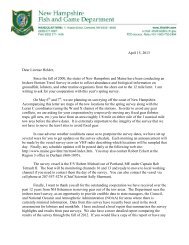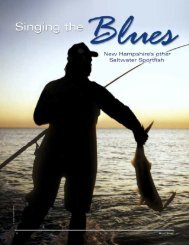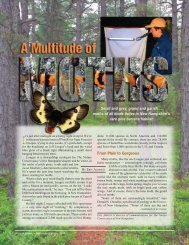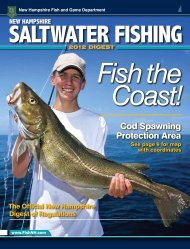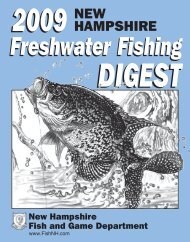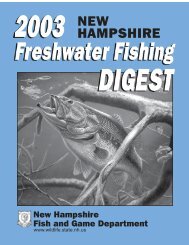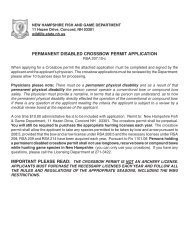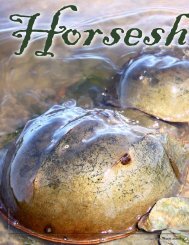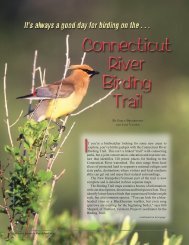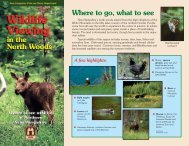Where the Wild Cat Roams - New Hampshire Fish and Game ...
Where the Wild Cat Roams - New Hampshire Fish and Game ...
Where the Wild Cat Roams - New Hampshire Fish and Game ...
- No tags were found...
Create successful ePaper yourself
Turn your PDF publications into a flip-book with our unique Google optimized e-Paper software.
North American bobcat(Lynx rufus)A stubby tail gives <strong>the</strong> bobcat its name, but here are <strong>the</strong> o<strong>the</strong>r features of this NorthAmerican wildcat:U The average weight is 15 pounds for females; 26 for males.U The average length is 31 inches for females; 34 for males.U It has ear tufts that are shorter than one inch <strong>and</strong> also tufts of hair around its cheeks thatgive its face a squarish appearance.U A bobcat’s hind legs are longer than its forelegs, helping it to pounce <strong>and</strong> catch cottontailrabbits, snowshoe hare, mice, squirrels, groundhogs, birds <strong>and</strong> even porcupines. It alsowill catch prey as small as insects – or as large as white-tailed deer.U Litters can range from one kitten to as many as 6, but <strong>the</strong> average litter size is 2 or 3.U Tracks me<strong>and</strong>er in a formation similar to one that a housecat would leave, but <strong>the</strong> tracksare bigger: 1¾ to 2½ inches long <strong>and</strong> 1¾ to 2½ inches wide in dirt; 2½ inches long <strong>and</strong>2¾ inches wide in snow. Claw marks are not visible.©usda / terry spivey photo / bugwood.org©roger irwin photo©john davy photo©roger irwin photofrom sou<strong>the</strong>rn Canada to central Mexico. Increasingpelt prices <strong>and</strong> fear of possible overharvest resultedin <strong>the</strong> listing of <strong>the</strong> bobcat on Appendix II of <strong>the</strong>Convention on International Trade in EndangeredSpecies (CITES). This ensured that internationaltrade would not harm <strong>the</strong> survival of <strong>the</strong> bobcat asa species. Oversight responsibility ultimately fell to<strong>the</strong> U.S. <strong>Fish</strong> &<strong>Wild</strong>life Service, which worked withstates to protect <strong>the</strong> bobcat from overharvest, whileallowing states to keep some form of hunting <strong>and</strong>trapping if appropriate. <strong>New</strong> <strong>Hampshire</strong> decided toclose <strong>the</strong> bobcat season <strong>and</strong> make it illegal to hunt ortrap bobcats, because <strong>the</strong>re were so few in <strong>the</strong> state.“Around 1984 is when we were seeing a populationdecline in <strong>New</strong> <strong>Hampshire</strong>, to <strong>the</strong> point where onlyabout two dozen bobcats a year were being huntedor trapped,” says John Litvaitis, a wildlife ecologyprofessor at <strong>the</strong> University of <strong>New</strong> <strong>Hampshire</strong>. “Thepopulation had reached such a low point that trackinga small harvest would mean a lot of effort for <strong>the</strong>state.”“Bobcats are an odd duck, so to speak, in that <strong>the</strong>yare not listed as an endangered species, but <strong>the</strong>y stillhave a fair amount of federal oversight,” Litvaitissays. The N.H. <strong>Wild</strong>life Action Plan lists bobcats asa species of greatest conservation need in <strong>the</strong> state– mostly because of a decline in available bobcathabitat, <strong>and</strong> in part because <strong>the</strong>ir current populationnumbers are not known.Tracking <strong>the</strong> <strong>Cat</strong>sIn early 2009, trappers will have a chance to see<strong>the</strong>se beauties up close if <strong>the</strong>y participate in a livecaptureresearch study being conducted by N.H. <strong>Fish</strong><strong>and</strong> <strong>Game</strong> <strong>and</strong> <strong>the</strong> University of <strong>New</strong> <strong>Hampshire</strong>.Litvaitis says that involving people who are alreadyknowledgeable about trapping seemed a natural fitfor this research.“Trapping a bobcat is more of an intellectual challengeof matching wits than it is with a coyote or afisher,” says Litvaitis, who will head <strong>the</strong> researchteam for N.H. <strong>Fish</strong> <strong>and</strong> <strong>Game</strong>. “Getting a bobcat tostep into your trap is a real talent <strong>and</strong> a lot of luck.”Along with luck, <strong>the</strong> trappers will learn <strong>the</strong> researchprotocol for catching bobcats using modified, paddedleg hold traps, which are a type of trap listed by <strong>the</strong>U.S. Department of Agriculture for wildlife relocationefforts. These have been successfully used for bobcatBobcats exhibit short black ear tufts; retractableclaws; <strong>and</strong> white patches of fur behind <strong>the</strong> ears.10 November/December 2008 • <strong>Wild</strong>life Journal



